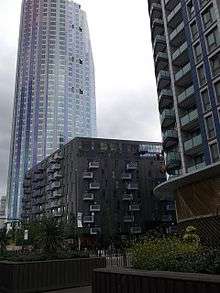Stratford, London
| Stratford | |
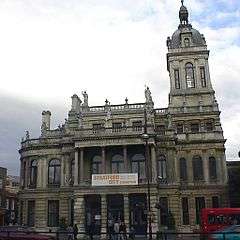 Stratford Old Town Hall |
|
 Stratford |
|
| Population | 7,292 (2001[1]) 17,768 (2011 Census. Stratford and New Town Ward)[2] |
|---|---|
| OS grid reference | TQ385845 |
| – Charing Cross | 6 mi (9.7 km) WSW |
| London borough | Newham |
| Ceremonial county | Greater London |
| Region | London |
| Country | England |
| Sovereign state | United Kingdom |
| Post town | LONDON |
| Postcode district | E15, E20 |
| Dialling code | 020 |
| Police | Metropolitan |
| Fire | London |
| Ambulance | London |
| EU Parliament | London |
| UK Parliament | West Ham |
| London Assembly | City and East |
Coordinates: 51°32′32″N 0°00′09″W / 51.5423°N 0.00256°W
Stratford is a district of the London Borough of Newham in East London, England, and a suburb of London 6 miles (9.7 km) east northeast of Charing Cross.[3]
Historically an agrarian settlement in the ancient parish of West Ham in the county of Essex, it was transformed into an industrial suburb following the introduction of the railway in 1839.
The late 20th Century was a period of severe economic decline, eventually reversed by regeneration associated with the 2012 Summer Olympics, for which Stratford’s Queen Elizabeth Olympic Park was the principal venue.
Stratford is now East London’s primary retail, cultural and leisure centre. It has also become the second most significant (after Canary Wharf) business location in the east of the capital.
History
Stratford’s early significance as the point where the originally Roman road from Aldgate in the City, to Romford, Chelmsford and Colchester, crossed the River Lea. At that time the various branches of the river were tidal and unchannelised, while the marshes surrounding them had yet to be drained. The Lea valley formed a natural boundary between Essex on the eastern bank and Middlesex on the west, and was a formidable obstacle to overland trade and travel.
Original ford and Place Name origin
The name is first recorded in 1067 as Strætforda and means 'ford on a Roman road'.[4] It is formed from Old English 'stræt' (in modern English ‘street’) and 'ford'. The former crossing lay at an uncertain location north of Stratford High Street.
The district of Old Ford in northern Bow – west of the Lea and now in Tower Hamlets – is named after the former crossing, while Bow itself was also initially named Stratford, after the same ford, and a variety of suffixes were used to distinguish the two distinct settlements.[4]
The settlement to the east of the Lea was also known as Estratford referring to the location east of the other Stratford[citation needed], Statford Hamme alluding to the location within the parish of West Ham, Abbei Stratford, referring to the presence of Stratford Langthorne Abbey.[4] and Stretford Langthorne after a distinctive thorn tree (probably a pollarded Hawthorn) which was mentioned in a charter of 958 AD.
Bow Bridge
In 1110 Matilda, wife of Henry I, reputedly took a tumble at the ford on her way to Barking Abbey, and ordered a distinctively bow shaped (arched) bridge to be built over the Lea, together with a causeway across the marshes along the line now occupied by Stratford High Street.
The western Stratford then become suffixed by “-atte-Bow” (at the Bow), eventually becoming known simply as Bow, while over time the eastern Stratford lost its “Langthorne” suffix.
_p18b_-_Bow_Bridge.jpg)
The Bridge was repaired and upgraded many times over the centuries until eventually demolished and replaced in the 19th Century.
Stratford Langthorne Abbey
In 1135 the Cistercian Order founded Stratford Langthorne Abbey, also known as West Ham Abbey. This became one of the largest and most wealthy monasteries in England, owning 1,500 acres (610 hectares) in the immediate area and 20 manors throughout Essex.[5]
The Abbey lay between the Channelsea River and Marsh Lane (Manor Road). Nothing visible remains on the site, as after it dissolution by Henry VIII in 1538, local landowners took away much of the stone for their own buildings and the land was subsequently urbanised.
A stone window and a carving featuring skulls – thought to have been over the door to the charnel house – remain in All Saints Church, West Ham (dating from about 1180). The Great Gate of the abbey survived in Baker's Row until 1825.[6]

The coat of arms of the Abbey can be seen over the doorway to the Old Court House, in Tramway Avenue (Stratford). The chevrons from this device, originally from the arms of the Mountfitchet family, together with an abbot's crozier were incorporated into the arms of the former County Borough of West Ham in 1887. The same arms were adopted by the new London Borough of Newham in 1965.[7]
Industrialisation
The industrialisation of Stratford started slowly and accelerated rapidly in the early Victorian era.

The Stratford and national experience of the Industrial Revolution inspired scenes in the 2012 Olympic Opening Ceremony covering the traumatic transition from a ‘Green and Pleasant Land’ to the ‘Pandemonium’ of the revolution and the huge social and economic changes it brought.
Pre-industrial Economy
Stratford was originally an agricultural community, whose proximity to London provided a ready market for its produce. By the 18th century, the area around Stratford was noted for potato growing, a business that continued into the mid-1800s.[8] Stratford also became a desirable country retreat for wealthy merchants and financiers, within an easy ride of the City. When Daniel Defoe visited Stratford in 1722, he reported that it had "...increased in buildings to a strange degree, within the compass of about 20 or 30 years past at the most". He continues that "...this increase is, generally speaking, of hansom large houses... being chiefly for the habitations of the richest citizens, such as either are able to keep two houses, one in the country, and one in the city; or for such citizens as being rich, and having left off trade, live altogether in these neighbouring villages, for the pleasure and health of the latter part of their days".[9]
Early Developments
An early industrial undertaking at Stratford was the Bow porcelain factory, which despite the name, was on the Essex side of the River Lea. Using a process that was patented in 1744, Edward Heylin and Thomas Frye operated a factory near Bow Bridge called "New Canton" to produce some of the first soft-paste porcelain to be made in the country.[10] The site of the factory was to the north of Stratford High Street near the modern Bow Flyover; it was the subject of archaeological excavations in 1921 and 1969.[11]
Victorian Acceleration
By the early 19th century, Stratford was an important transport hub, with omnibuses and coaches running into London four times every hour and coaches from East Anglia passing through hourly. The route into London was plied by Walter Hancock's steam coaches for a period during the 1830s.[12] A small dock and a number of wharves were operating on the River Lea at Stratford by the 1820s, serving the needs of local industries. However, the opening of the nearby Royal Victoria Dock in 1855 and the subsequent construction of the Royal Group of Docks (at one time the largest area of impounded water in the world), increased Stratford's importance as a transport and manufacturing centre.[13] Rising population levels led to two major new Anglican churches in the area, St John's Church in 1834 and Christ Church in 1851.

Stratford station was opened on 20 June 1839 by the Eastern Counties Railway (ECR). The Northern and Eastern Railway opened a section of its authorised line from Broxbourne to join the ECR at Stratford on 15 September 1840.[14] A railway works and depot for engines and rolling stock was established by Great Eastern in 1847 to the north of Stratford. At its peak, the works employed over 2,500 many of whom had homes, along with other rail workers, in the town that developed nearby. It was originally called Hudson Town, after George Hudson, the "Railway King;", but after his involvement in bribery and fraud was revealed in 1849, the settlement quickly became better known as Stratford New Town, which by 1862 had a population of 20,000.[15] During the lifetime of the Stratford works, 1,682 locomotives, 5,500 passenger coaches and 33,000 goods wagons were built.
The last part of the works closed in March 1991.[16]
20th Century
Stratford, like many areas of London, particularly in the East End, suffered significant de-industrialisation in the 20th century.[17] This was compounded by the closing of the London Docks in the 1960s.[18] Around this time, the Stratford Shopping Centre was built, beginning efforts to guide the area through the process of transformation from a working-class industrial and transport hub to a retail and leisure destination for the contemporary age.[17] These efforts continued with the Olympic bid for Stratford, and the ongoing urban regeneration work going on there.[19]
Geography and Local government
Stratford began as a hamlet in the NW part of the ancient parish of West Ham, as the area urbanised it expanded, increased in population and merged with neighbouring districts.
Except as a ward, Stratford has never been a unit of administration and so, like many London districts, lacks formally defined boundaries. As described however, Stratford occupies the north-west part of West Ham and so takes the NW boundaries of that area; boundaries which have subsequently become the NW boundary of the modern London Borough of Newham.
In this way the River Lea and the complex network of the Bow Back Rivers mark the western limits of the area, which also extends north as far as the boundary of the London Borough of Waltham Forest.
Local Government
Stratford was one of three ancient wards in the large parish of West Ham, in the Becontree hundred of Essex. It came within the Metropolitan Police District in 1840.[20]

Despite forming part of the built up area of London the parish remained outside the statutory metropolitan area established in 1855 and the County of London established in 1889. Instead, administrative reform was undertaken in the area in much the same way as a large provincial town. A local board was formed in 1856 under the Public Health Act 1848 and subsequently the parish was incorporated as a municipal borough in 1886. In 1889 the borough was large enough in terms of population to become a county borough and was outside the area of responsibility of Essex County Council. Stratford formed the centre of administration of the county borough and was the location of the town hall.
In 1965 West Ham was reunited with East Ham (Ham is believed to have formed a single unit until the late 12th century) and small areas of neighbouring districts, to form the London Borough of Newham, part of the new Greater London.
The modern borough has an electoral ward named 'Stratford and New Town'.
Post Code districts
The Royal Mail has given the postcode E20 to the Olympic Park and Stratford City developments; this was only used by the BBC TV soap EastEnders for the fictional suburb of Walford.[21]
Walford is a portmanteau of the names of two East London districts; nearby Walthamstow and Stratford itself.
 |
Hackney Wick | Leyton | Wanstead |  |
| Bow including Old Ford | |
Forest Gate | ||
| ||||
| | ||||
| Bromley | Plaistow | Upton Park |
Demography
As of the 2011 census, White British is the largest ethnic group in the Stratford and New Town ward, at 21% of the population, followed by Other White at 19% and Black African at 13%.[22]
Economy
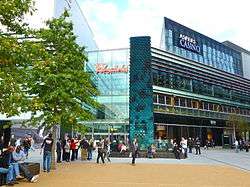
Both of Stratford's shopping centres: The Stratford Centre and the recently opened (2011) Westfield Stratford City are located on either side of Stratford station. Westfield Stratford City, home to 350 stores, is one of the largest shopping centres in Europe. The older centre has a range of accessibly-priced stores, its indoor and outdoor market stalls, and the 'inshops' network of small retail outlets. The centre occupies much of the 'island site' created in the 1960s by the surrounding gyratory traffic system.
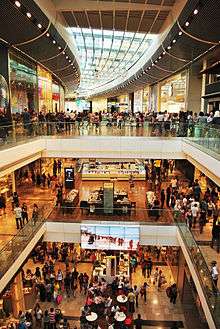
Redevelopment
Stratford has been a focus of regeneration for some years, and is the location of a number of major projects.
Complete developments:
- Westfield Stratford City is a multibillion-pound scheme to regenerate the 73-hectare brownfield railway lands to the north of the existing town centre. The vast shopping centre reported to be bigger in size than Bluewater was opened in September 2011. It has anchor stores for John Lewis, Waitrose and Marks and Spencer, in addition to other household names like Apple and Primark. The centre boasts a range of restaurant outlets, a cinema and casino, making it a leisure destination in itself, as well as its shopping facilities. Nearby will be a new purpose-built community of 5,000 homes, offices, schools, public spaces, municipal and other facilities destined to become a major metropolitan centre for East London, all to coincide with the opening of the Olympics in July 2012.
- The 2012 Olympic and Paralympic Games had their main base at the Olympic Park, which contained a significant number of venues including the Olympic Stadium, Aquatics Centre, and London Velopark. What was the athletes' Olympic Village is to be restructured as the new East Village development, providing 3,500 homes, half affordable and half private. The post-Olympics legacy plans include the largest new urban park in Europe for over a century, and the new Chobham Academy.
- Improving Stratford station with new platforms, walkways and entrances.
- 150 High Street, Stratford, a 41-storey 133 m (436 ft) high residential tower.
Current Olympic Park developments:
- Construction of East Wick & Sweetwater neighbourhoods will see up to 1,500 homes built[23]
- Olympicopolis; A plan in the Olympic Park to see the Victoria & Albert Museum and University College London to have facilities by 2018.[24]
- International Quarter; will see 13 Office and 2 residential buildings as well as a hotel.[25]
- iCity; a technology development will see Loughborough University establish a tech campus. Other companies are yet to be announced.
Other current developments:
- Stratford Centre is proposing to re-develop its site, with a 26 story residential building for students and to have additional parking and shops in the shopping centre.[26]
- Stratford Plaza building
- Broadway Chambers development with 39-story and 20-story buildings with 388 apartments[27]
- Olympian Tower; a 26 Story building.[28]
- Strand East; will see 1,200 homes as well as space for technology businesses and amenities[29][30]
- Rebuilding of Pudding Mill Lane DLR station as part of the Crossrail project[31]
Transport
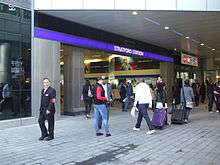
Stratford is a significant transport hub, well served by bus routes, and with five railway stations.
- Stratford Regional
Stratford Regional is located on the National Rail Great Eastern Main Line, North London Line as well as the Lea Valley Lines. National Rail services: Abellio Greater Anglia, TfL Rail and London Overground. London Underground's Central and Jubilee lines both serve the regional station and link Stratford to Oxford Street, Wembley Stadium, Epping and Canary Wharf. The Jubilee line was extended to Stratford in 1999.
The Docklands Light Railway (DLR) was extended to Stratford in 1987, and to Stratford International in 2011, with services to Poplar, Canary Wharf, Lewisham, London City Airport, the Excel Centre, Beckton and Woolwich Arsenal. A bus station is located adjacent to Stratford Regional with London Buses and National Express coach routes towards central, northeast London and Stansted Airport.[32]
- Stratford International and Stratford High Street
Stratford International, located to the northwest, is on the HS1 line from St Pancras International to Kent, and is served by Southeastern domestic high speed services; so far, no decision has been made for international Eurostar services to call. The International and Regional stations are linked by a branch of the Docklands Light Railway – opened in August 2011 – which also serves a new DLR only station at Stratford High Street to the south of Stratford, situated on the site of the former Stratford Market railway station.
- Maryland
The eastern part of Stratford is served by Maryland railway station. The Liverpool Street- Shenfield via Ilford and Romford service known as the Shenfield Metro service and runs every 10 minutes and is operated by TfL Rail. This service also calls at Stratford and is planned to be incorporated into the Crossrail service by 2017.
- Pudding Mill Lane
Pudding Mill Lane is in the south of the Olympic Park (though it closed during the Olympics for safety reasons due to its size), and normally provides transport to the local factories. Served by the Docklands Light Railway to Stratford, Poplar and Canary Wharf, it is planned to be re-sited south as part of the Crossrail project.
Landmarks
Church of St John the Evangelist
Stratford Broadway, the main thoroughfare, is dominated by the 1830s Anglican parish church of St John's. In its churchyard is a memorial to the Stratford Martyrs, who were burned at the stake in 1556 during the reign of Queen Mary. The memorial itself is octagonal with terracotta plaques on each face, surmounted by a twelve sided spire. It was unveiled in 1878.[33]
Gurney Memorial Drinking Fountain
Directly to the south of the churchyard stands a 12.80-metre tall granite obelisk, which was erected in 1861 as a memorial to the Quaker philanthropist and abolitionist, Samuel Gurney (1766 to 1856). The plinth carries two brass drinking fountain heads on opposite sides, and the inscription; IN REMEMBRANCE OF SAMUEL GURNEY / WHO DIED 5 June 1856 / ERECTED BY HIS FELLOW PARISHIONERS AND FRIENDS / 1861 / "When the ear heard him then it blessed him"[34] (a paraphrase from the Book of Job, Chapter 29 verse 11).
Old Town Hall
Designed by Lewis Angell and John Giles in the Italianate style with a 100-foot (30.5-metre) tall domed tower, it opened in 1869 as the public offices for the West Ham Local board of health. It later became the town hall for the county borough and was enlarged in 1881 to accommodate a courthouse and cells.[35] On 26 June 1982, the main part of the building was badly damaged by fire; after a painstaking reconstruction of the original features and refurbishment as a conference centre, it was reopened by the Queen in July 1986. It is a Grade II Listed Building.[36]
King Edward VII public house
Opposite St John's Church stands an early 19th-century pub, the King Edward VII with original pedimented doors and early 19th-century bay windows. It is a Grade II Listed Building.[37]
It was originally called "The King of Prussia", either in honour of Frederick the Great or else after King Frederick William IV who visited the area in 1842 to meet Elizabeth Fry, the prison reformer.
In 1914, the first year of World War One, the pub was renamed[38] in honour of the reigning king, Edward VII. The old name was problematic as ‘The King of Prussia’ was one of the titles of the German Emperor, Kaiser Wilhelm II. More than a hundred years later, the King Edward VII pub is still locally nicknamed ‘The Prussian’.
"Robert" the tank engine
A 38 tonne 0-6-0 saddle-tank steam locomotive named "Robert" is displayed in Meridian Square, the forecourt of Stratford Station. It was built in 1933 by the Avonside Engine Company of Bristol for use at the Lamport Ironstone mines railway near Brixworth, Northamptonshire. It was previously an exhibit at the North Woolwich Old Station Museum, but moved to Stratford in 1999. In 2008, it was removed to the East Anglia Railway Museum at Chappel and Wakes Colne railway station near Colchester; there it was cleaned and repainted at the expense of the Olympic Delivery Authority and returned to Stratford in 2011.[39]
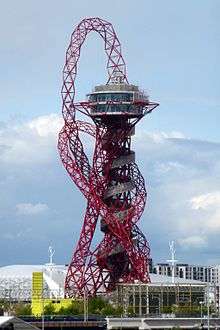
ArcelorMittal Orbit
A 114-metre-tall (374 ft) sculpture and observation tower in the Queen Elizabeth Olympic Park. It is Britain's largest piece of public art, and is intended to be a permanent legacy of the 2012 Summer Olympics. It closed after the end of the Games, but was re-opened to the public in April 2014.[40]

Abbey Mills Pumping Station
Built in 1868 as part of the new London sewerage system by Sir Joseph Bazalgette, the building originally housed steam pumps and is a notable example of Italian style Gothic Revival architecture. It is opened to the public on an occasional basis, when the "flamboyant interior of enriched cast ironwork" can be seen. It was used to portray a lunatic asylum in the 2005 film Batman Begins, and is a Grade II* listed building.[41]
Culture
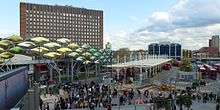
Stratford's Cultural Quarter, adjacent to the shopping centre, is home to several arts venues, bars and cafes:
- Theatre Royal Stratford East – NB: 'Stratford East' is not a location; the 'East' is used to differentiate between Stratford (east London) and Stratford-upon-Avon
- Stratford Circus
- The Discover Children's Story Centre is a partner in the Cultural Quarter
Stratford has been the location for numerous films, notably Sparrows Can't Sing (1963) and Bronco Bullfrog (1970). The promotional film for the Beatles' "Penny Lane" single was filmed in and around the southern part of Angel Lane, demolished in the late 1960s to build the Stratford Centre. Damnably Records relocated to Stratford from Forest Gate in 2014 and is run by George Gargan, a Manor Park born musician from the band Former Utopia and Lazarus Clamp (1999–2003).
Education
The University of East London (UEL) has a major campus in Stratford, whose main building, University House, is a historic listed building dating from the 19th Century. The adjacent Passmore Edwards Building is also one of the area's most historic and beautiful buildings, with colourful frescoes and domed roof. In addition, Birkbeck College, part of the University of London, has launched courses in the area, initially using space provided by UEL, with a view to constructing its own campus in Stratford. A new university is planned on the Olympic Park following the 2012 Olympic Games.
People from Stratford
- See Category:People from Stratford, London
- Anja Katherine Hencken of Paoli
See also
- Stratford City
- Stratford Martyrs
- Maryland, London
- List of people from Newham
- List of schools in Newham
References
- ↑ Stratford neighbourhood.statistics.gov.uk
- ↑ "Newham Ward population 2011". Neighbourhood Statistics. Office for National Statistics. Retrieved 17 October 2016.
- ↑ Mayor of London (February 2008). "London Plan (Consolidated with Alterations since 2004)" (PDF). Greater London Authority.
- 1 2 3 Mills, D. (2000). Oxford Dictionary of London Place Names. Oxford.
- ↑ West Ham: Stratford Abbey, A History of the County of Essex: Volume 6 (1973), pp. 112–14 Date accessed: 28 April 2008
- ↑ Powell, W R (editor). "A History of the County of Essex: Volume 6. West Ham: Stratford Abbey, pages 112–114)". www.british-history.ac.uk. British History Online. Retrieved 8 November 2015.
- ↑ "NEWHAM, LONDON BOROUGH OF". www.civicheraldry.co.uk. Civic Heraldry of England and Wales. Retrieved 8 November 2015.
- ↑ W R Powell (editor), A History of the County of Essex: Volume 5, Victoria County History 1966, Metropolitan Essex since 1850: Population growth and the built-up area (pp. 2–9)
- ↑ Defoe, Daniel (1722), A tour thro' the whole island of Great Britain, divided into circuits or journies (Volume I, Letter I)
- ↑ "Industries: Pottery, Bow porcelain".
- ↑ "Bow Porcelain – 34 – The Newham Story".
- ↑ "West Ham: Transport and postal services".
- ↑ "West Ham: Rivers, bridges, wharfs and docks".
- ↑ White, H.P. (1987). Thomas, David St John, eds. A Regional History of the Railways of Great Britain — Volume 3: Greater London (3rd ed.). Dawlish: David & Charles.
- ↑ "The northern suburbs: The Lea and Stratford-le-Bow".
- ↑ "Stratford Railway Works – General Offices Building – The Newham Story".
- 1 2 lhttp://www.rgs.org/OurWork/Schools/Fieldwork+and+local+learning/Planning+your+fieldtrip/Fieldwork+locations/London+2012+Olympic+Park/Stratford.htm
- ↑ http://news.bbc.co.uk/local/london/hi/people_and_places/2012/newsid_9041000/9041124.stm
- ↑ http://www.stratfordlondon.info/
- ↑ West Ham – Local government and public services | A History of the County of Essex: Volume 6 (pp. 96–112). British-history.ac.uk. Retrieved 17 July 2013.
- ↑ BBC News: London – Olympic Park to share EastEnders' Walford E20 postcode. Retrieved 19 March 2011
- ↑ Services, Good Stuff IT. "Stratford and New Town - UK Census Data 2011". ukcensusdata.com.
- ↑ London Legacy Development Corp. East Wick & Sweetwater. Retrieved 31 December 2013
- ↑ London Evening Standard: 'Olympicopolis': Multi-million pound cultural hub planned for Olympic Park. Retrieved 31 December 2013
- ↑ The International Quarter: Plots and Areas. Retrieved 31 December 2013
- ↑ Stratford Centre: Development. Retrieved 31 December 2013
- ↑ Stratford Renaissance: Broadway Chambers. Retrieved 31 December 2013
- ↑ Stratford Renaissance: Olympian Tower. Retrieved 31 December 2013
- ↑ Strand East: About 31 December 2013
- ↑ LLDC: Developments around the park 31 December 2013
- ↑ Crossrail: REPLACEMENT DLR STATION AT PUDDING MILL LANE APPROVED AND WILL ENABLE CROSSRAIL TUNNELS TO PROCEED. Retrieved 31 December 2013
- ↑ Transport for London, Windsor House, 42–50 Victoria Street, London SW1H 0TL, enquire@tfl.gov.uk. "Every Journey Matters – Transport for London" (PDF).
- ↑ Good Stuff. "Martyrs' Memorial – Newham – Greater London – England – British Listed Buildings".
- ↑ "Full Record PMSA – VADS: the online resource for visual arts".
- ↑ "1869 – Public Office & Vestry Hall, Stratford, London". archiseek.com. Retrieved 25 October 2014.
- ↑ "The Old Town Hall Stratford". stratfordlondon.info/. Stratford Renaissance Partnership. Retrieved 25 October 2014.
- ↑ Good Stuff. "King Edward Vii Public House – Newham – Greater London – England – British Listed Buildings".
- ↑ "Stratford's Free Art & History.".
- ↑ "London 2012 News".
- ↑ "ArcelorMittal Orbit". queenelizabetholympicpark.co.uk. London Legacy Development Corporation. Retrieved 6 March 2014.
- ↑ Good Stuff. "Abbey Mills Pumping Station – Newham – Greater London – England – British Listed Buildings".
External links
| Wikimedia Commons has media related to Stratford, London. |
- Description of Stratford in 1876
- Archaeology at the Olympic site
- History of Stratford site with links to historic Post Office directories
- A Brief History Of The Parish Of Stratford
- Local guide to and blog about contemporary Stratford
